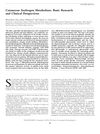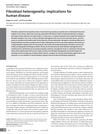Histochemical and Immunohistochemical Markers for Human Eccrine and Apocrine Sweat Glands: An Aid for Histopathologic Differentiation of Sweat Gland Tumors
November 2001
in “
Journal of Investigative Dermatology Symposium Proceedings
”
histochemical markers immunohistochemical markers apocrine sweat glands eccrine sweat glands sweat gland tumors neuraminidase-sensitive anionic sites mitochondrion-like secretory granules EGF-like antigenicity 70 kDa glycoprotein human milk fat globule membranes dark cell granules chondroitinase ABC-sensitive anionic sites alkaline phosphatase activity CEA GCDFP-15 anti-EMA monoclonal antibody E29 epidermal growth factor carcinoembryonic antigen gross cystic disease fluid protein-15 epithelial membrane antigen
TLDR Markers help differentiate between apocrine and eccrine sweat glands to identify sweat gland tumors.
The document reviewed histochemical and immunohistochemical markers to differentiate between human eccrine and apocrine sweat glands, aiding in the diagnosis of sweat gland tumors. Key findings included the identification of specific markers such as HMFG-1 and a 70kDa glycoprotein from human milk fat globule membrane, which reacted with apocrine but not eccrine glands. Common markers like GCDFP-15 and CEA were found in both gland types. The study emphasized the importance of these markers in accurately classifying sweat gland tumors and understanding their histogenesis.




